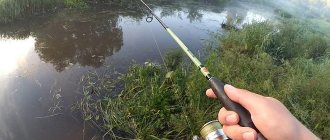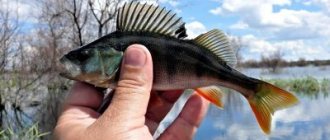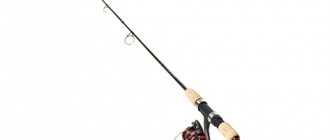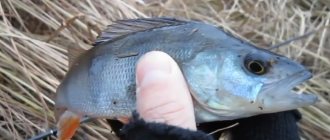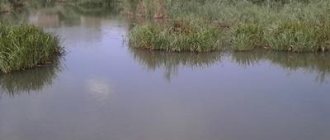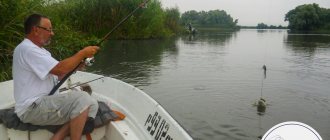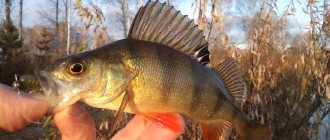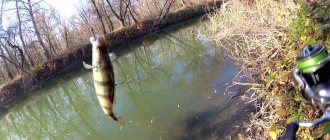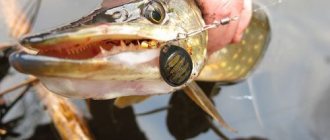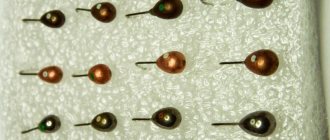After spawning, this fish gathers in small schools that scour the reservoir in search of the best food supply. That is why you can see signs of the presence of perch in any corner of the reservoir. In summer, it energetically moves around the water area, eating small animals and not forgetting to hide from larger predators, in particular pike. Its diet mainly consists of bottom invertebrates (worms, leeches and other small things), insect larvae and fry of peaceful fish species.
The hot summer period is not a reason to sheath your spinning rod and switch to catching peaceful fish. In the summer you can excellently hunt for perch, because this predator is active all year round, which means it is accessible. The arrival of the warm season does not in any way affect his excellent appetite. He continues to chase the fry, delighting the fishermen with stable catches.
Experienced spinning anglers know very well where to look and how to catch the striped robber in the summer, but beginners will have to comprehend this science. By the way, perch is an excellent object for those who are planning to master spinning fishing.
So where can you find bass?
Choosing gear for perch fishing
Choose a spinning rod of the light category.
Perch is a coveted trophy not only for beginning spinners, but also for athletes who have thoroughly studied the habits and behavioral characteristics of this fish. This predator can be very picky about the quality of the bait and its wiring. But choosing the right gear for catching this fish will increase your chance of success.
1. Spinning
If you choose the right spinning rod taking into account the characteristics of fishing, fishing will definitely bring a lot of emotions and leave pleasant memories. Catching perch with modern high-quality tackle is very convenient. If you have the skills, you can make long and accurate casts. Animate the correct movement of the bait and catch trophies without any problems.
Test and length. When hunting for perch, a spinning rod is selected in the light category with test characteristics of up to 12 grams and a length ranging from 190 to 230 centimeters. For fishing from the shore, a spinning rod can be used a little longer. But when fishing in places where tree crowns overhang, you can get caught in their branches and lose your bait.
The rod should fit comfortably in the hand, be light and sensitive.
Build. Perch fishing mainly occurs with small, light baits, for which a large rod test is not needed. A spinning rod with a fast action would be optimal. This formation will allow you to maximize your casting distance and catch perch with thinner equipment.
Reel and line. The rod is equipped with a small spinning reel with a spool capacity of 1000 - 2000. Typically, perch is caught on a simple monofilament with a diameter of no more than 0.18 millimeters. When using a braided thread, a diameter of 0.10 millimeters is enough, because the strength of the braid is much greater.
You cannot use large and bulky baits.
So, let's summarize.
Fast action spinning rod with small dough (up to 12 g), length up to 2.3 m (depending on conditions)
A spinning reel with a spool with a capacity of 1000 to 2000 (according to the Japanese classification). With high-quality laying of thin fishing line or cord.
At this time, you can catch perch with a spinning rod from the shore without using a boat. The rising water floods coastal areas with all kinds of vegetation, near which the striped predator sets up ambushes. Therefore, moving bait along the shore often brings good results.
Perch fishing gear
To successfully catch the striped robber, you need to acquire the appropriate gear.
Today, the market sells a huge assortment of suitable fishing rods, spinning reels, fishing lines with cords, and various perch baits. Important!
For catching perch with a spinning rod, you can put together a really budget kit that will not be too inferior in performance to expensive gear. This is especially true for beginners who are not yet ready to make large financial investments in fishing. A spinning rod for perch should be light and fit comfortably in your hand. With it, the angler will feel any bites from a predator and can easily throw various baits. Of course, now let’s leave out specialized areas of fishing, such as microjig and twitching, and consider what parameters a universal fishing rod should meet:
- Length around 2.10 meters. On small bodies of water or in a boat, you can take a shorter stick; in large areas, it is advisable to lengthen it.
- Test up to 8–12 grams. When using ultralight baits, choose fishing rods up to 5–7 grams.
- Build quickly. It is the most universal and suitable for all types of perch baits.
The lighter the spinning rod for perch, the better. Such tackle will be very convenient to use, will not tire you out over a whole day of fishing and will allow you to really enjoy the fishing process, even in the absence of bites.
The reel for perch is used in a small size. An important condition is maintaining a balance with the spinning rod. The most universal inertia-free motors have the following parameters:
- Size 1500–2500. More is meaningless, less is not entirely suitable for spinning in general.
- Weight up to 250 grams. Less is better.
- Reduction 5.0–5.5:1. Too high-speed reels are of no use, as are traction reels.
Particular attention should be paid to the quality of the line laying. The fact is that thin cords and nylons are used for perch. Not every reel can work with small diameters. The inertia-free motion should be light and smooth, without backlash or knocking.
Photo 1. Tackle for perch.
Due to the thickness of the fishing line, there is also a requirement for the quality of operation of the friction mechanism. Despite the relatively small size of the perch, if the brake does not work well, then the bait may break off, which is doubly offensive when a decent-sized humpback whale lands.
When catching striped robber, you can use either monofilament or braided fishing line. Both options are approximately equivalent, so it is advisable to have a reel with several spools, where both the line and the nylon will be wound.
Monofilament fishing line is advisable when fishing with front-loaded spinners. These lures twist the line very much, even double swivels do not help. In addition, monofilament is less noticeable, which is important for clear water and pressed-in reservoirs. The stretchability of nylon allows it to better absorb the jerks of the fish, but deprives it of the sensitivity that is achieved only with a braided cord.
Equipment options
In addition to the standard design, when a leash with bait is tied to the fishing line, there are several more options:
Spaced equipment. In this case, the load and bait are separated using a leash. There are 2 types: Carolina - when the sinker is attached higher along the line, and the bait is tied to the end of the line, and Moscow - when the sinker is attached to the end of the line, and the bait is tied higher using a leash. The Muscovite is also known as a diverting leash.
Dropshot rig. In this case, the sinker is also tied to the end of the fishing line, and above it, a hook is tied directly to the main fishing line. A good option for spot fishing.
Since perch is rarely caught under normal conditions larger than 0.5 kg, a spinning rod is required that is elegant and lightweight.
Perch fishing technique
To catch perch, spinners use different methods of placing baits. The most common of them are uniform and stepped wiring, twitching.
Uniform wiring is used when fishing with spinners, spoons, wobblers and silicone baits. This method of wiring works well in spring and summer when fishing at shallow depths.
Stepped retrieving is used mainly in the fall when fishing at depths of more than 2.5 m. In this way, they “play” with front-loaded spinners, spoons and jig baits. It is important to select the required ratio of the time the bait falls and the length of the fishing line.
When fishing for perch, the pause during retrieval should be from 1 to 8 seconds. After the bait touches the bottom, you must immediately continue rotating the reel.
When jerking a wobbler (twitching), the duration of the pause after the jerk depends on the water temperature. In cold water (autumn) the duration of the pause reaches 8-10 s, and in warm water in hot summer weather the stop is reduced to a minimum.
The spinning test is indicated on each rod or spinning rod. It looks like numbers, for example test 0.3 - 12 g. This means that the tackle is intended for a wobbler, silicone or spinner of the specified weight.
What is spinning?
Spinning is a tackle much shorter than a fishing rod. As a rule, its length ranges from 1.7 to 3.3 m. It is made, in particular, from materials:
- carbon;
- fiberglass;
- composite
[ THERE IS AN ANSWER ] How to make a boom for perch fishing
Each of the materials is quite durable and is successfully used in fishing equipment. But for perch fishing, it is best to take a rod made of mixed materials.
Why mixed?
- If you buy a carbon spinning rod, then when you lightly hit a branch or something else, a microcrack occurs. And then when hooked they simply break. This happens quite often among beginners. Therefore, they must be handled very carefully. It is ideal for more experienced anglers.
- As for fiberglass, it is not sensitive enough and not very flexible for bass fishing. Even if the test on it is from 0.3 to 0.17 g, it still does not feel as much as we would like. Most often they are used either for pike or for feeder.
- Composite A rod made of this material is most often mixed with carbon. In addition, if the tackle is cheaper than carbon and has carbon written on it, then it is 100% composite spinning rod.
Composite
– a middle option between fiberglass and carbon. But, it is very inferior to carbon fiber spinning rods due to its low sensitivity. But its huge advantage is that most often they are universal equipment.
The mixed version will show even the minimum impact of the perch, and is more flexible and reliable in strength.
Catching perch with a spinning rod or lure is interesting, both from the shore and from a boat, and in its activity, it is a very exciting and dynamic way of fishing. In spring, summer and autumn, a large number of perches are caught using spinning rods, using various baits, spoons, spinners and spinners, as well as perch wobblers. Many fishermen like to jig fish with silicone baits. And also very often, when catching pike perch and pike by trolling, good humpback salmon are also caught in the line.
What does perch bite on in the summer on a spinning rod?
The best rods to use are the blanks that are called “trout” or “micro-jig” all over the world, but in our country they are called perch. The length of the rod is 2.10 – 2.40 meters, with a test from two to ten grams. The reel is inertialess, small in size. The fishing line is no thicker than 0.2mm.
As for the baits used for catching perch, the four most proven classes are suitable:
1. Rotating spoons (with a wide blade that allow you to make slow retrieves, 3, 4, and fifth numbers). There are several varieties of such spinners, but as the name itself shows, they have one thing in common - a rotating petal that imitates the activity of small fish. Their choice depends on the place and time of fishing, as well as on the color of the water. The main advantage of spinners over other spinners for catching perch in heavily overgrown areas of the water is that when moving, the petal of the spinner pushes apart the algae encountered along the way and thus protects the hooks of the tee from snagging on aquatic vegetation.
2. Oscillating spoons.
3. Wobblers.
4. Jig bait.
If large-sized perch does not mix with small fish (small perch does not interfere), then small baits can be used. If you get tired of small things, then it is recommended to switch to a large attachment (wobblers). The only drawback is that the bait, equipped with two tee hooks, often irritates the perch, and in this case it is preferable to use an oscillating spoon.
Perch is a schooling fish, and you can see how a predator that has grabbed the bait is accompanied by its striped brothers before leaving the water, weaving around and trying to snatch the hanging bait from its mouth. It is also interesting that several applications with a wobbler or twister lure the predator almost close to the boat. Then you can fish with this bait like a jig, right from the side. True, a large perch will not stay near the boat for long, but fish weighing two hundred to three hundred grams can be caught this way. But, after some time, the flock begins to feel danger and moves away from the place that is not good for it.
The most catchy twisters for catching perch in early summer are light ones. Most often, white and yellow baits are used for catching perch; the perch takes on dark ones only when shiny dots are interspersed in the body of the twister. There are practically no bites on evenly colored blue and black twisters. But the largest perches bite on a wobbler.
Where to catch perch with a spinning rod
It is better to catch perch in the summer with a spinning rod in the early morning, at this time predators go out hunting, while, carried away by the pursuit of prey, the perches often scatter in different directions and are quite far from the camp. On a hot sunny day, these predators gather again and stand in shady places, in thick grass and under burdocks, overhanging trees over the water or under a steep bank, until the heat subsides, and at the same time they no longer hunt, lying in wait for their prey from their ambushes.
The striped predator is superior to pike in its gluttony. With an abundance of small fish, humpback whales often gorge themselves to the point that the fry that do not fit in their stomachs stick out of their mouths; before they have time to swallow one fish, they grab another. With a strong drop in atmospheric pressure and a sharp change in weather for the worse, as well as during periods of extreme heat, striped predators practically do not feed, like many other fish, so there is no point in catching perch with a spinning rod during such periods.
With the exception of these weather extremes, these predatory fish eat every day, and if they do not go to the fisherman as prey, it is probably only because a well-fed and overfed, and ultimately lazy fish, is always more careful, prudent and picky than a hungry one, which rushes like mad at the bait. This representative from the order of perciformes is so greedy and careless, and has little fear of noise, with the exception of large individuals, that it can be caught by casting with spoons and wobblers for ten months of the year.
Spring perch bite better early in the morning
Fishing for perch with a spinning rod in the summer - in shallow waters
In July and August, perch congregate in grassy shallows where whitebait are abundant. It is not possible to catch it in such places with spoons, wobblers with deepening, and especially jigs.
In such conditions, you can fish exclusively with surface wobblers: poppers, walkers and gliders. Fishing with them is not as productive as with baits with deepening, but the moment of the bite can be seen with your own eyes, which undoubtedly makes the fishing process colorful.
When it comes to what type of surface baits bass respond best to in the summer, there's no doubt that it's poppers.
The gurgling sound made by the baits during the retrieve, as well as splashes and splashes, imitate a competing perch that is chasing the fry in the near-surface layer.
Striped fish that are nearby instinctively attack the popper, protecting their territory from uninvited guests, and get hooked.
It was not for nothing that I used the last word in the previous sentence in the plural. As mentioned earlier, perch is a schooling fish. Striped animals do not attack the enemy on their territory alone, but in groups.
Therefore, when fishing with a popper, most often not one, but two or even three tails are dangling on the tees.
When fishing for perch, the rule “the smaller the bait, the more bites” usually applies. Therefore, many spinning anglers think that they need to buy the smallest poppers for a striped predator.
But in reality, you don’t have to waste time on trifles. Even small bass aggressively attack topwaters measuring 8-10 cm, although baits of this length are considered pike.
Catching a popper in mid-summer and August does not mean non-stop jerking of the rod. If you fish like this, you won’t catch anything. On the contrary, you will only scare away the fish.
There must be 2-3 second pauses in the wiring. A good perch fishing for a popper is alternating 2-3 jerks with stops, during which you can lightly play along with the rod.
Many anglers who have tried fishing with poppers complain about poor bite results. They say the perch attacks the bait, but misses.
Most often, this happens because the angler makes the hook before the bait is in the fish's mouth.
Attention! A splash near the wobbler does not mean a bite!!! The signal that a perch has grabbed a popper is a characteristic blow to the hand.
So if you want to productively catch perch with poppers and other topwaters in August, or any other month of the summer, train yourself to automatically hook fish earlier than expected.
Perch on a spinning rod in autumn
Catching perch in the fall is much more effective with bottom baits (jig, drop-shot)
There are several nuances and key differences in spinning perch fishing in the fall from other seasons, namely:
- Weather. In the fall it is usually too cloudy and unpredictable, which is critical when fishing for perch.
- Upcoming winter. This is the main reason for the improvement in the bite in the fall, namely from the end of August.
- As a rule, humpback fish bite equally well at any time of the day.
- In mid-September, the fry, which is attacked by our predator, begins to go deeper and deeper, which attracts our prey with it.
Based on these aspects, we can say that the key to successful autumn fishing is the mastery of fishing at depth, but any difficulties at this time of year will be rewarded with a large number of larger fish.
Catching perch on a retractable leash - fishing technique with Moscow equipment, correct tying and choice of bait.
Which poppers to choose and how attractive this bait is for perch, about the catchability of poppers for perch.
Spinners, regardless of design, must have this quality. Wobblers that imitate whitebait should also have a reflective coating in attractive colors. Lures painted yellow and silver are most attractive to this predator.
How to catch perch in summer using a spinning rod
According to the angler, you need to catch perch with the appropriate gear. Then fishing turns into a kind of sporting competition, and that’s when you get maximum pleasure from it.
Going for perch with gear set for pike or catfish is akin to shooting sparrows from a cannon. If catching a large predator is primarily a test of the strength of the gear, then perch hunting, in the sense of throwing out a spinning rod and the thickness of the fishing line, is a test of harmony and grace. For the most part, perch are not large fish, and trophies weighing more than a kilogram are already spoken of with respect as an outstanding trophy.
It is necessary to make the gear you use as light as possible, because when fishing for perch, the rule “the thinner the line, the bigger the fish” works with mathematical precision, and the pleasure of landing a three-hundred-gram perch on a 0.18 mm fishing line. turns out to be no less than a ten kilogram catfish per twenty pound braided line.
A large perch sits on the hook of the bait immediately, confidently and firmly. Its bite is difficult to confuse with fussy pushes and blows of small things. The bite of a humpback perch is similar to hooks, only after some time of contact there is a smooth and powerful resistance. The thin rod bends into an arc and an exciting fight with the underwater enemy begins. A rigid and powerful rod in this situation is not a help, but rather a hindrance. The perch's lips and the membrane lining its mouth are fragile, and rough tackle easily tears them. The flexible rod easily dampens the desperate jerks of hooked fish. Thus, with a certain skill, you can bring out a respectable perch, barely hanging on the very tip of the lip.
A one-kilogram perch brought to the boat can, of course, be taken into a landing net, but it is best, of course, to be grabbed by the lower jaw with your hand.
Lures for fishing
This predator can be caught equally well on both rotating and oscillating spoons.
As for baits, there can be no clear recommendation or advice. It won’t be difficult to catch a “striper” using wobblers, proppers and other artificial baits.
[THERE IS AN ANSWER] How to catch perch with a retractable leash
The main rule of perch fishing is not to use too bulky or massive baits. The average weight of a spinner or wobbler is 5 grams. Another important feature that must be present in artificial lures for perch is shine.
Spinners, regardless of design, must have this quality. Wobblers that imitate whitebait should also have a reflective coating in attractive colors. Lures painted yellow and silver are most attractive to this predator.
Large perch, as a rule, take at great depths, so for such conditions you should choose a rod with a weight of up to 10g. Moreover, the rod must be durable and reliable so that you can use various types of wiring.
Catching perch with a spinning rod, rigs, baits and fishing secrets
Fishing with a spinning rod is a very exciting activity. In Russia, this fishing method has been known for more than 100 years. The essence of the method is that the bait is cast a considerable distance from the boat or shore, and with the help of a reel it is reeled in to the fisherman. Translated from English, the word “spinning” means rotation, which very accurately explains the behavior of the bait in the water, which attracts predatory fish.
When mastering this fishing method, a beginner should start with fish, which, as a rule, does not offer much resistance when playing.
Perch is a trophy not only for novice fishermen, but also for professionals who have well studied the habits and behavioral characteristics of this fish. This predator can be very indiscriminate in the quality of bait and bait, but the correct choice of gear for catching this fish will greatly increase the chance of success.
If you are planning a targeted hunt for perch, then the spinning rod is selected in the “light” category with a test weight of up to 15 g.
If the reservoir is inhabited mainly by small perches weighing up to 200 grams, then you can use “ultralight” with artificial microbait weighing 2 - 3 grams.
The reel is selected in such a way that, as a result of the work of the rod-reel tandem, the spinning rod becomes a single whole, a monolithic mechanism for landing fish. If the reel does not match the “weight category” of the fishing rod, then the correct operation of these two systems will not work.
The fishing line must be at least 0.20 mm in diameter , even if you do not plan to fish for trophy specimens. The safety margin will not be superfluous if a heavier fish with a “cool” character bites on the artificial bait.
As for baits, there can be no clear recommendation or advice. It won’t be difficult to catch a “striper” using wobblers, proppers and other artificial baits.
The main rule of perch fishing is not to use too bulky or massive baits. The average weight of a spinner or wobbler is 5 grams. Another important feature that must be present in artificial lures for perch is shine.
Spinners, regardless of design, must have this quality. Wobblers that imitate whitebait should also have a reflective coating in attractive colors. Lures painted yellow and silver are most attractive to this predator.
The most popular. The advantage of this method of equipping spinning tackle is that the bait is almost 100% unhooked. This is important when fishing for perch in heavily snarled places.
The bait is installed as follows:
- to an offset hook so that the hook tip is completely immersed in the soft material.
- The hook can be supplemented with a small streamlined sinker , which is attached to the hook using a winding ring. Loading such equipment is necessary in cases where fishing is carried out in the water column, and it is almost impossible to carry out such a placement of a light rubber bait without additional weight.
This fishing method differs slightly from the Texas method, and consists in placing the sinker at some distance from the hook with the bait.
When installing a drop-shot rig, the sinker is located at the end of the fishing line, and the bait is located some distance from it. The tackle is also equipped with an offset hook on which a silicone bait is strung.
Very simple equipment that can be used in spinning fishing. The sinker is attached to the main line, and the bait or lure is attached to a lead, which can be sliding, at a distance of at least 20 cm from the sinker.
When fishing in a current, you need to look for places where, behind natural barriers or artificial structures, the strength of the current will be minimal. Sections of rivers where reverse flows form are also promising. Perch likes to feed on the border between direct and reverse currents. In such places, the likelihood of this predator catching fish that is wounded or stunned and does not try to resist the flow of water, but moves in circles, increases significantly.
When fishing from a boat, you should choose a spinning rod no more than 2 meters long. If fishing is carried out from a rubber boat, then landing even a medium-sized perch should be done using a landing net, since at the very last moment this nimble predator can go under the boat, and the tee sticking out of its mouth can damage the material of the craft.
When choosing gear for fishing in winter, especially in severe frosts, preference should be given to budget gear. The resistance of the fish when playing is insignificant, and negative temperatures do not have the best effect on the durability of the spinning rod.
In winter, spinning rods are used with guide rings of such a diameter that frozen water cannot block the fishing line in them, and the reel should be comfortable to work with gloves on.
The best baits in winter are spinners , the retrieval of which should be very slow, since the predator is inactive at this time. Wobblers can be used effectively only on warm winter days, when the air temperature is significantly above 0 degrees.
Lures for perch
A predator such as perch can be caught with any bait, not large in size, but among the wide variety there are the most catchy specimens.
The main artificial baits for perch are rotating and oscillating spoons. At the same time, we should highlight models in yellow and white colors, as well as models with a halographic or fluorescent sticker.
Spinners
A characteristic feature of these spinners is the presence of a rotating blade. In addition, they differ in petal size, loading method and shape. At shallow depths, you should use a size 00-2 spoon, according to the Mepps classification. At great depths (over 2 meters), using stepped wiring, it is better to use specimens of sizes 2-4. A high-quality spinner will always work flawlessly at the lowest retrieve speed.
Wobblers
Wobblers are considered one of the best baits when hunting striped predators. Wobblers are selected according to their working depth of immersion. In the spring, when underwater vegetation has not begun to rapidly grow, deep-sea models can be used. At the same time, a “herringbone” type wiring is used, when the wobbler dives and rests on the bottom, after which there is a pause for the wobbler to float up. Bites, as a rule, occur while the wobbler is being baited.
In the summer, surface baits such as poppers and walkers show good results. Retrieving such baits is done in jerks. The predator attacks such bait during a pause.
Silicone baits
Lures made from edible silicone are very popular among fishermen. Such baits are made of silicone, into which a flavor is introduced. Moreover, the flavor can be different from the aroma of shrimp to the aroma of garlic, etc.
The conversation in this article will be about catching perch from the shore on ponds and small lakes. The specificity of such reservoirs is pleasing in that there is no seasonal migration of perch, and therefore you can fish here from the end of the spring spawning ban and almost until freeze-up with the same baits using the same gear.
The conversation in this article will be about catching perch from the shore on ponds and small lakes. The specificity of such reservoirs is pleasing in that there is no seasonal migration of perch, and therefore you can fish here from the end of the spring spawning ban and almost until freeze-up with the same baits using the same gear.
However, maximum interest for a spinning player begins in late spring and throughout the summer. At this time, a huge number of vacationers and fishermen, who love to fish in comfort on a clean shore without dense thickets, occupy the shores of large reservoirs, and for this reason, small lakes unsuitable for these tasks are usually deserted - in any case, in the early morning. And actually at dawn you need to start catching perch with a spinning rod.
Of course, bodies of water vary. Where you won’t get a perch bite before ten in the morning, but I know one good pond where all summer long perch can be caught only from dawn until about 10 o’clock, and the hotter the sun gets, the more the number of bites drops. As soon as it begins to get light, the perch begins to drive the fry en masse into the grass in shallow water, which can be seen with the naked eye.
You should approach the place where perch is hunted as quietly as possible. In waders, you should approach the edge of the grass and make casts along it or at a slight angle (photo 1). In such conditions, 2-inch vibrating tails and twisters, often in natural colors, on a jig head weighing from 2 to 4 grams are very catchy (photo 2).
And in general, I noticed: where the perch actively chases the fry, there are no better baits than these. No matter how much my friends and I tried to throw various “creatures” into these “mini-cauldrons,” the result was always not so great—bites happened, but we always had to wait for them. But as soon as the bait was thrown “under the fry” at the same point, the perch greedily attacked it, sometimes immediately after splashdown. Various “crawfish” are also effective baits, but for some reason they work better for me in large deep-sea reservoirs.
Now about fishing when fishing for actively feeding perch. The bait should run away from the striped robber, and not dance in front of his face, which, of course, arouses his suspicion. It often simply does not respond to slow wiring. You increase the speed of the retrieve, slow it down just a little - and you immediately get a bite. The wiring is, naturally, pelagic. So you need to experiment not only with baits, but also with their presentation.
[THERE IS AN ANSWER] How to make a balda for perch fishing
Of course, it’s good when the perch chases the fry. It’s immediately obvious that the striped fish is active, and this adds excitement to the fisherman, but what to do on a hot day, when even a light breeze won’t touch the water surface, and all around is the tedious buzzing of insects? On such seemingly hopeless days, slugs on light jig heads can quite help (photo 3). Wiring is “mormyshing”, and very intensive. First you need to select an animation for the “worm”, observing the behavior of the bait at different amplitudes of wiring.
Then choose the most efficient wiring (or several interesting ones) and focus on them. It is not necessary to constantly change baits, it is better to experiment with wiring - and the perch, despite the heat, will be tempted sooner or later (photo 4). It seems that the active “play” of the slug, and at a low retrieve speed, brings out of its stupor even a perch “sweating” from the heat.
Developing the theme of overgrown shallow waters, it makes sense to remember the popper. You must have at least one such bait in your perch arsenal - especially where a dense carpet of algae spreads just under the surface (photo 5). By the way, in such areas fishing with a microjig with a bombard is very effective, but this is not quite ultralight.
In addition to the typical reservoirs with shallow areas overgrown with algae, there are quite often ponds and quarries that are small in area but quite deep. In clear areas, looking for perch in them is a thankless task, but fishing among flooded snags and/or among the stems of water lilies can be very productive.
I remember ten years ago, having unsuccessfully missed a spinning rod before lunch, I decided to explore an area overgrown with water lilies with a small spinnerbait. Wavy wiring with swaying among the stems - and the bites were not long in coming. The joy, however, did not last long that day - the miniature spinnerbait was easily bitten off by the pike, but I drew conclusions. Such baits are very effective, and not only those equipped with a “skirt”. Here, for example, is an interesting model (photo 6).
In the original bait from the Lucky Craft company, the lead whitebait vibrates slightly when retrieving, but in the replica in my arsenal it behaves like a regular sinker. Praise be to the Japanese engineers who showed a technical approach even in such a small detail, but... in terms of catchability, I have not yet noticed the difference between the original and the fake. Maybe it was just a successful copy, or maybe for other fish, for example salmon, the original will be many times better - time will tell.
In the same conditions – snags or vertical stems of underwater plants – a “spinner” with a twister on an offset hook is quite catchy (photo 7). In general, I’ve somehow moved away from fishing with rotating spoons, I use them only on the rivers of the Arctic, but a tandem with a twister is such a bait!
Helped me out more than once on a variety of bodies of water. In our case (small lakes and ponds) there is no point in using spoons larger than No. 2, and perhaps a twister longer than two inches. But for reservoirs and deep rivers, where there is a chance to meet a trophy humpback whale, the size of the tandem components can be increased. Take note, it might come in handy.
Some quarries, despite the small surface area, can have decent depths, and the difference in depths can be significant. I was convinced of this in winter when fishing with a balance beam on a cascade of artificial reservoirs. The places are interesting: under one hole there are 7 m, under another – 3, and the holes are a few steps away from each other. If the perch is on the dump even in the summer, then how to get to it and how to tempt it?
I immediately discarded various leash rigs - this is not an ultralight theme, all aesthetics are lost. Jig? Too easy. A mini rattlin came to the rescue (photo 8). And it later came in handy not only in quarries, but also in those reservoirs where the depth allowed it to be pulled in a wavy line near the bottom.
Well, now about all-season gear for catching perch in the reservoirs indicated above. Solid tips, tubular... In my opinion, there is no need to focus on this - almost any rod is suitable for pelagic fishing, the main thing is that its structure does not resemble a stake.
The set, which was purchased exclusively for catching pond trout, turned out to be in demand in perch fishing - and subsequently became tool No. 1. In fact, there is nothing special about it: trout are also caught in shallow water, where they search deeper along the horizons, using silicone jigs lures, tempt with pelagic postings of active baits.
Points worth paying attention to:
Choosing a spinning rod for catching perch from the shore
Fishing for perch with a spinning rod is a very delicate matter, each angler has his own taste, but the optimal and most common option looks like this.
Average characteristics of a spinning rod for perch:
- spinning should be light, so ultralight;
- dough from 0.2 to 0.15 g;
- the length of the spinning rod for fishing from the shore should be in the range from 1.7 to 2.1 m (from a boat 1.5 m);
- the action is preferably medium, although it all depends on the fishing location;
- the material is better to be mixed with carbon.
To catch perch with a spinning rod, you need light equipment, but very sensitive and long-range. If these moments coincide, then the bite will always be visible, and the fishing will be a success.
